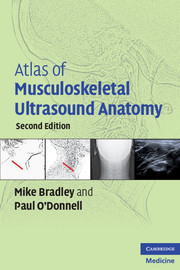Foreword
Published online by Cambridge University Press: 07 May 2010
Summary
The quality of ultrasonic images has seen radical improvement over the last couple of years, and – as can be appreciated in the new edition of this Atlas of Musculoskeletal Ultrasound Anatomy – high frequency applications such as musculoskeletal ultrasound have profited from this development.
Significant advances in ultrasonic probe design and refined manufacturing techniques have resulted in transducers with outstandingly high bandwidth and sensitivity to provide ultrasonic images with both excellent spatial resolution and penetration at the same time. State-of-the-art transducer technology also boosts Doppler performance and supports advanced imaging functions such as trapezoid scan for an extended field of view at no loss of spatial resolution. High frequency matrix transducers make use of genuine 4-D imaging technology to achieve finer and more uniform ultrasonic beams in all three dimensions to deliver the most superb and artefact-free images from the very near to the far field.
Also the dramatic increase of processing power in premium ultrasound systems such as the Aplio XG, with which most of the cases described in this book were acquired, has triggered a quantum leap in image quality. Advanced platforms can process the amount of data worth one DVD each second, which allows us to implement the most complex signal processing algorithms to improve image quality, suppress artefacts and extract the desired information from the ultrasonic raw data in real time.
- Type
- Chapter
- Information
- Atlas of Musculoskeletal Ultrasound Anatomy , pp. vii - viiiPublisher: Cambridge University PressPrint publication year: 2009



